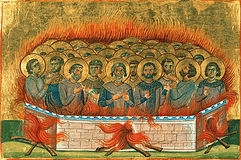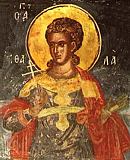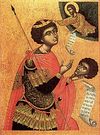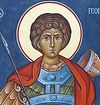

| Previous day | Next day |
| Old Style
November 3
|
Wednesday |
New Style
November 16
|
|
23rd Week after Pentecost.
Tone 5.
Fast Day. |
Wine and oil allowed.
|
![]() Hieromartyrs Acepsimas, bishop, the priest Joseph, and the deacon Aeithalas, of Persia (376).
Hieromartyrs Acepsimas, bishop, the priest Joseph, and the deacon Aeithalas, of Persia (376). ![]() Dedication of the Church of the Great-martyr George in Lydda (4th c.).
Dedication of the Church of the Great-martyr George in Lydda (4th c.).
Martyrs Atticus, Agapius, Eudoxius, Carterius, Istucarius (Styrax), Pactobius (Tobias), Nictopolion, and companions, at Sebaste (320). St. Acepsimas, hermit, of Cyrrhus in Syria (4th c.). St. Snandulia of Persia (380). St. Anna, daughter of Prince Vsevolod I Yaroslavich (1112).
New Hieromartyrs Nicholas Dinariev, archpriest, of Danevo (Ryazan) (1918); Paul Andreyev and Alexander Zverev, archpriests, of Vozmishche (Moscow), Sergius Kedrov, archpriest, of Faustovo (Moscow), Alexander Parusnikov, archpriest, of Ramenskoye (Moscow), Vladimir Pisarev, archpriest, of Kostino (Moscow), and Vincent Smirnov, archpriest, of Khimki (Moscow) (1937).
St. Achaemonides (or Hormisdas), confessor, of Persia (4th c.). St. Winifred of Holywell, Wales (630). St. Hubert, bishop of Liege (727). St. Pirmin, bishop and monastic founder (Germany) (753). St. Theodore, confessor, bishop of Ancyra (8th-9th c.). The Meeting [1196] of St. Sava [1235] and St. Symeon the Myrrh-gusher [1200], of Serbia, at Vatopedi [Mt. Athos]. St. Nicholas of Iveron (Mt. Athos) and Georgia, hymnographer (1308). St. Pimen, monk of Zographou (Mt. Athos) (1610). New Hieromartyr George, priest, of Neopolis, Asia Minor (1797).
Thoughts for Each Day of the Year
According to the Daily Church Readings from the Word of God
By St. Theophan the Recluse

Wednesday. [I Thess. 4:1-12; Luke 11:42-46]
The Lord reproaches His contemporaries by saying that they pass over the judgement and the love of God. The drying up of righteousness and love is the root of all disharmony both in society and in every person. It comes from the predominance of self-love or egoism. When egoism enters the heart an entire horde of passions is multiplied. It itself strikes out against righteousness and love, which require selflessness; while the passions generated from it chase away all other virtues. And the person becomes, by his heart’s disposition, unsuitable for anything that is truly good. He can still tithe mint and rue and all manner of herbs, but he does not have the courage to do anything more substantial. This does not mean that his outer behaviour is improper. No, in every way it is adorned with decency, only on the inside he is as a grave which appeareth not, and the men that walk over it are not aware of it. The beginning of self-correction is the beginning of the appearance of selflessness in the heart, after which righteousness and love are restored. Then, one after the other, all other virtues begin coming to life. Then the person becomes noble in the eyes of God because of his heart’s dispositon, although on the outside he may sometimes seem unprepossessing to other people. But the judgement of man is not an important thing, provided that God’s judgement is not against us.
Articles
 Martyr Aithalas of PersiaThe Holy Martyr Aithalas the Deacon, by order of the Persian emperor Sapor II, was put to death by stoning in the year 380 for confessing Christ. |
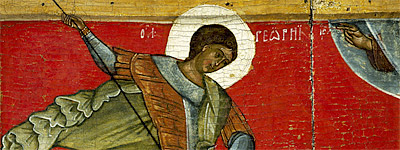 Great Martyr George |
 Venerable Akepsimas the Hermit of Cyrrhus in SyriaSaint Akepsimas, Hermit of Cyrrhus in Syria lived for sixty years in the desert, not far from Cairo. |
 Saint Snandulia of PersiaSnandulia was a devout Christian of the city of Arbela who visited those who suffered in prison for the sake of Christ. |
